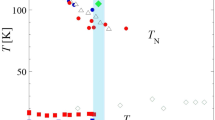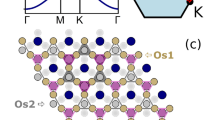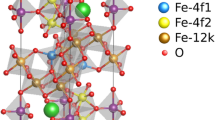Abstract
The heavy rare earth elements crystallize into hexagonally close packed (h.c.p.) structures and share a common outer electronic configuration, differing only in the number of 4f electrons they have1. These chemically inert 4f electrons set up localized magnetic moments, which are coupled via an indirect exchange interaction involving the conduction electrons. This leads to the formation of a wide variety of magnetic structures, the periodicities of which are often incommensurate with the underlying crystal lattice2. Such incommensurate ordering is associated with a ‘webbed’ topology3,4 of the momentum space surface separating the occupied and unoccupied electron states (the Fermi surface). The shape of this surface—and hence the magnetic structure—for the heavy rare earth elements is known to depend on the ratio of the interplanar spacing c and the interatomic, intraplanar spacing a of the h.c.p. lattice5. A theoretical understanding of this problem is, however, far from complete. Here, using gadolinium as a prototype for all the heavy rare earth elements, we generate a unified magnetic phase diagram, which unequivocally links the magnetic structures of the heavy rare earths to their lattice parameters. In addition to verifying the importance of the c/a ratio, we find that the atomic unit cell volume plays a separate, distinct role in determining the magnetic properties: we show that the trend from ferromagnetism to incommensurate ordering as atomic number increases is connected to the concomitant decrease in unit cell volume. This volume decrease occurs because of the so-called lanthanide contraction6, where the addition of electrons to the poorly shielding 4f orbitals leads to an increase in effective nuclear charge and, correspondingly, a decrease in ionic radii.
This is a preview of subscription content, access via your institution
Access options
Subscribe to this journal
Receive 51 print issues and online access
$199.00 per year
only $3.90 per issue
Buy this article
- Purchase on Springer Link
- Instant access to full article PDF
Prices may be subject to local taxes which are calculated during checkout




Similar content being viewed by others
References
Gschneidner, K. A. & Eyring, L. (eds) Handbook on the Physics and Chemistry of Rare Earths Vol. 1 (North Holland, Amsterdam, 1978)
Jensen, J. & Mackintosh, A. K. Rare Earth Magnetism 286–304 (Clarendon, Oxford, 1991)
Keeton, S. C. & Loucks, T. L. Electronic structure of rare-earth metals. I. Relativistic augmented-plane-wave calculations. Phys. Rev. 168, 672–678 (1968)
Fretwell, H. M. et al. Fermi surface as the driving mechanism for helical antiferromagnetic ordering in Gd-Y alloys. Phys. Rev. Lett. 82, 3867–3870 (1999)
Cracknell, A. P. & Wong, K. C. The Fermi Surface (Clarendon, Oxford, 1973)
Taylor, K. N. R. & Darby, M. I. Physics of Rare Earth Solids 60–62 (Chapman and Hall, London, 1972)
Hubbard, J. Magnetism of iron. II. Phys. Rev. B 20, 4584–4595 (1979)
Gyorffy, B. L., Pindor, A. J., Staunton, J., Stocks, G. M. & Winter, H. A first-principles theory of ferromagnetic phase transitions in metals. J. Phys. F 15, 1337–1386 (1985)
Heinemann, M. & Temmerman, W. M. Magnetic structures of hcp bulk gadolinium. Phys. Rev. B 49, 4348–4351 (1994)
Kurz, P., Bihlmayer, G. & Blügel, S. Magnetism and electronic structure of hcp Gd and the Gd(0001) surface. J. Phys. Condens. Matter 14, 6353–6371 (2002)
Eriksson, O. et al. Bulk and surface magnetism and interplanar spacings in Gd from first-principles calculations. Phys. Rev. B 52, 4420–4426 (1995)
Harmon, B. N., Antropov, V. P., Liechtenstein, A. I., Solovyev, I. V. & Anisimov, V. I. Calculation of magneto-optical properties for 4f systems: LSDA + Hubbard U results. J. Phys. Chem. Solids 56, 1521–1524 (1994)
Perdew, J. P. & Zunger, A. Self-interaction correction to density-functional approximations for many-electron systems. Phys. Rev. B 23, 5048–5079 (1981)
Strange, P., Svane, A., Temmerman, W. M., Szotek, Z. & Winter, H. Understanding the valency of rare earths from first-principles theory. Nature 399, 756–758 (1999)
Lüders, M. et al. Self-interaction correction in multiple scattering theory. Phys. Rev. B 71, 205109 (2005)
Rado, G. T. & Suhl, H. (eds) Magnetism Vol. IIB 337–377 (Academic Press, New York, 1966)
Staunton, J. B. & Gyorffy, B. L. Onsager cavity fields in itinerant-electron paramagnets. Phys. Rev. Lett. 69, 371–374 (1992)
Turek, I., Kudrnovský, J., Bihlmayer, G. & Blügel, S. Ab initio theory of exchange interactions and the Curie temperature of bulk Gd. J. Phys. Condens. Matter 15, 2771–2782 (2003)
Andrianov, A. V. Helical magnetic structures in heavy rare-earth metals as a probable manifestation of the electronic topological transition. J. Magn. Magn. Mater. 140–144, 749–750 (1995)
Lifshitz, I. M. Anomalies of electron characteristics of a metal in the high pressure region. Sov. Phys. JETP 11, 1130–1135 (1960)
Blanter, Y. M., Kaganov, M. I., Pantsulaya, A. V. & Varlamov, A. A. The theory of electronic topological transitions. Phys. Rep. 245, 159–257 (1994)
Evenson, W. E. & Liu, S. H. Generalized susceptibilities and magnetic ordering of heavy rare earths. Phys. Rev. Lett. 21, 432–434 (1968)
Dugdale, S. B. et al. Direct observation and calipering of the “webbing” Fermi surface of yttrium. Phys. Rev. Lett. 79, 941–944 (1997)
Nordström, L. & Mavromaras, A. Magnetic ordering of the heavy rare earths. Europhys. Lett. 49, 775–781 (2000)
Andrianov, A. V., Kosarev, D. I. & Beskrovnyi, A. I. Helical magnetic ordering in Tb completely suppressed by uniaxial tension: Evidence of electronic topological transition and support for the nesting hypothesis. Phys. Rev. B 62, 13844–13847 (2000)
Milstein, F. & Robinson, L. B. Magnetic transitions in alloys of gadolinium and dysprosium. Phys. Rev. 159, 466–472 (1967)
Andrianov, A. V. & Chistiakov, O. D. Evidence of pressure-induced antiferromagnetism in ferromagnetic Ho0. 4 Gd0. 6 . Phys. Rev. B 55, 14107–14108 (1997)
Blundell, S. Magnetism in Condensed Matter 91–92 (Oxford Univ. Press, Oxford, 2001)
Acknowledgements
This work was supported by the EPSRC (UK) and the CCLRC’s Centre for Materials Physics and Chemistry. Computing resources were provided by the CSC at the University of Warwick, as well as the CCLRC’s e-Science facility and the John von Neumann Institute for Computing in Jülich.
Author information
Authors and Affiliations
Corresponding authors
Ethics declarations
Competing interests
Reprints and permissions information is available at www.nature.com/reprints. The authors declare no competing financial interests.
Supplementary information
Supplementary Information
This file contains Supplementary Methods, Supplementary Figure S1 with Legend and additional references. The Supplementary Methods section contains further details of the electronic structure techniques used in our investigation. Figure S1 shows the 3D Fermi surface of gadolinium. (PDF 651 kb)
Rights and permissions
About this article
Cite this article
Hughes, I., Däne, M., Ernst, A. et al. Lanthanide contraction and magnetism in the heavy rare earth elements. Nature 446, 650–653 (2007). https://doi.org/10.1038/nature05668
Received:
Accepted:
Issue Date:
DOI: https://doi.org/10.1038/nature05668
This article is cited by
-
Revisiting the magnetic structure of Holmium at high pressure by using neutron diffraction
Scientific Reports (2023)
-
Origin of the exotic electronic states in antiferromagnetic NdSb
npj Quantum Materials (2023)
-
Observation of conventional and inverse magnetocaloric effects in (Dy\(_{0.6}\)Gd\(_{0.4}\))\(_{5}\)Pd\(_{2}\)
Indian Journal of Physics (2023)
-
Rare-earth separation based on the differences of ionic magnetic moment via quasi-liquid strategy
Frontiers of Chemical Science and Engineering (2022)
-
Scandium recovery from ion-adsorption rare earth concentrate with HEHEHP as extractant
Journal of Central South University (2021)
Comments
By submitting a comment you agree to abide by our Terms and Community Guidelines. If you find something abusive or that does not comply with our terms or guidelines please flag it as inappropriate.



